
El día 19 de noviembre de 2025 se realizará una reunión satélite “Encuentro con el Sector Biotecnológico de Galicia” en el Museo MEGA.
Nos complace invitarles a participar en nuestra conferencia internacional anual, un evento de referencia que se ha consolidado como un espacio ideal para el networking entre profesionales del descubrimiento de fármacos, tanto de la academia como de la industria.
Cada año, seleccionamos un conjunto de temas clave para fomentar el intercambio de ideas y promover debates entre expertos con diversas formaciones y trayectorias, pero con un objetivo común: impulsar el desarrollo de nuevas terapias a través de la investigación en descubrimiento de fármacos, de forma multidisciplinar y traslacional. El programa de este año se centrará en tres áreas fundamentales:
Data Science & Artificial Intelligence (Chair: Patrick Aloy, IRB Barcelona)
Artificial intelligence (AI) has the potential to transform drug discovery, as it is reshaping other areas of science and technology. Indeed, when combined with data sciences, it offers a unique opportunity to merge multi-omics data and compound design, thus reintroducing biological complexity at the first steps of the drug discovery process. This session will explore potential strategies to bridge the gap between biological big data, drug screening experiments and state-of-the-art generative AI tools. We will also discuss how generative AI can be used to explore the uncharted chemical space and to design new chemical compounds (NCEs) with specific pharmacological properties. This might sound as fiction, but deep learning strategies have successfully designed NCEs with desired anticancer activities or new antibiotic scaffolds, and several ML-designed drugs are already in clinical trials. More specifically, this session will foster discussions on the role of data science and AI in:
•Target identification and characterization
•Compound screening and hit identification
•De novo drug design and hit-to-lead development
•Preclinical profiling, biomarker discovery and patient stratification
Drug Discovery Stories(Chair: Javier Terriente, Zeclinics) (ASEBIO)
The drug discovery journey: Lessons from academia and industry
The preclinical development of new therapeutics is a complex and multifaceted process.
Bringing a drug candidate from the lab to clinical trials—and ultimately to patients—requires a combination of scientific and non-scientific factors. On the scientific side, it involves identifying a suitable therapeutic target, developing a compound with strong efficacy, low toxicity, and good bioavailability in the target tissue. But there are other critical, though sometimes overlooked, factors as well—such as securing financial resources, gaining access to relevant disease models for proof-of-concept studies, and drawing on prior preclinical development experience.
In this session, we’ll hear from four promising biotech companies as they share the stories behind their latest drug development programs. They’ll also reflect on the lessons learned along the way. A key point of discussion will be: What role does being (or not being) a spin-off from academia play? Has that connection helped accelerate their development—or introduced limitations?
New Approach Methodologies (NAMs) (Chair: Jan Lichtenberg, InSphero)
Translating NAMs into practice: Scalable in vitro systems for efficacy and safety testing
The landscape of drug discovery is undergoing a transformative shift as New Approach Methodologies (NAMs) evolve from promising innovations to robust tools for efficacy and safety testing. This session will examine how recent advancements in cell biology, assay engineering, and data analytics are converging to support the deployment of human-relevant, in vitro systems at scale.
The maturation of 3D cell culture platforms, including microtissues, organoids, and organ-on-chip technologies, has enabled the development of models that recapitulate tissue architecture, function, and intercellular interactions with high fidelity. Coupled with deep profiling approaches such as high-content imaging and multi-omics readouts, these systems now deliver rich mechanistic data for both efficacy and toxicity assessments, including training of machine-learning systems. Moreover, increased access to high-quality primary cells and induced pluripotent stem cell (iPSC)-derived cell types has expanded the applicability of these platforms to disease modeling and precision medicine. Importantly, technical innovations in assay standardization, automation, and data integration are addressing key barriers related to reproducibility and scalability. This session will highlight how these integrated NAM solutions are advancing the predictive power of preclinical testing and enabling faster, cost-effective, and translationally relevant drug development pipelines.
Además, contaremos con una sesión de pósters, un espacio dedicado al desarrollo profesional y presentaciones tecnológicas de nuestras empresas patrocinadoras. Este año, también destacaremos los avances y capacidades del sector de descubrimiento de fármacos de la región de Galicia, que exhibirá sus logros de vanguardia en este campo.
La reunión de la SDDN está abierta a empresas interesadas en exponer sus productos, servicios y tecnologías, así como en patrocinar el evento.
El encuentro de la SDDN contará con un espacio de exposiciones donde las empresas podrán mostrar sus productos, servicios y tecnologías. Además, habrá la posibilidad de patrocinar el evento, lo que ofrecerá una visibilidad destacada para su marca. Para más información sobre patrocinio, por favor contáctenos en sddn2025@orzancongres.com.
Esperamos contar con su participación en este evento que promete ser una oportunidad inigualable para el intercambio de conocimientos y la creación de nuevas sinergias profesionales.

This website uses cookies to improve your experience. We'll assume you're ok with this, but you can opt-out if you wish. Read More